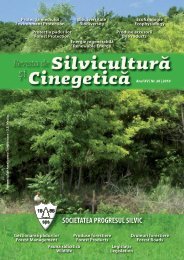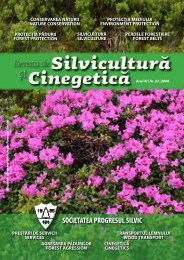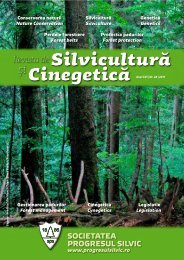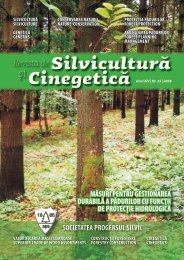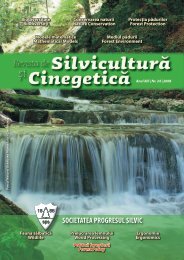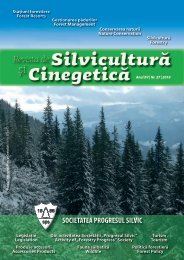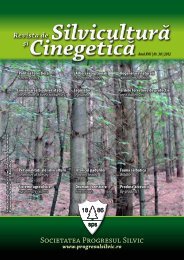Silviculture and Cinegetics Review - Societatea Progresul Silvic
Silviculture and Cinegetics Review - Societatea Progresul Silvic
Silviculture and Cinegetics Review - Societatea Progresul Silvic
Create successful ePaper yourself
Turn your PDF publications into a flip-book with our unique Google optimized e-Paper software.
FORESTRY BELTS SILVICULTURE AND CINEGETICS REVIEW XVII/30/2012<br />
marginal <strong>and</strong> post marginal rows (on the side of the<br />
road) with dual role of protection <strong>and</strong> l<strong>and</strong>scape were:<br />
elm leaved spirea, fly honeysuckle, lilac, jasmine, <strong>and</strong><br />
smoke tree. In the field belts the shrubs used were dog<br />
rose <strong>and</strong> hawthorn. Their behavior in different situations<br />
(types <strong>and</strong> composition of protection forest belts) is<br />
summarized below.<br />
Privet (Lygustrum vulgare) has been used mainly in the<br />
road belts, in marginal <strong>and</strong> post marginal rows, but in<br />
the central part as well, intimately mixed with principal<br />
tree species - oaks, maples, ashes. It develops well on a<br />
wide range of soils from chrnozems to alluvial soils,<br />
having an active growth. It forms rich shrubs that cover<br />
well the soil <strong>and</strong> contributes substantially to the<br />
adjustment of the penetrability of the forest belts. It has<br />
shallow roots, with many thin branches. This species<br />
sprouts, suckers <strong>and</strong> layer. With large ecological<br />
amplitude, resistant to drought <strong>and</strong> shade, it is the most<br />
recommended shrub species for the field <strong>and</strong><br />
communication forest belts, especially in their central<br />
core.<br />
Red dogwood (Cornus sanguinea) was used mainly in<br />
the communication paths <strong>and</strong> field protection belts at<br />
Bărăganu Station, showing similar qualities to privet. It<br />
forms rich shrubs that cover well the soil <strong>and</strong><br />
contributes substantially to the adjustment of the<br />
penetrability of the forest belts. It has shallow roots,<br />
with many thin branches. It sprouts <strong>and</strong> suckers.<br />
Supporting well the shading, it may be planted on the<br />
inner rows of the protection belts used in forest - steppe<br />
<strong>and</strong> forest zones.<br />
Photo 11.Călăraşi Red dogwood <strong>and</strong> privet in the marginal<br />
rows of the protection forest belts –Bărăganu Station, Călăraşi<br />
Photo 12. Red dogwood <strong>and</strong> privet in the marginal rows of<br />
the protection forest belts – Lacu Sărat, Brăila<br />
Cornel-tree (Cornus mas) was used rather rarely in the<br />
road protection belts, showing similar qualities to privet.<br />
It needs more heat <strong>and</strong> is more resistant to drought than<br />
privet, but it has a more open temperament than the<br />
latter. Its growth is very slow <strong>and</strong> it has very strong<br />
roots. It forms rich shrubs that cover well the soil <strong>and</strong><br />
contributes substantially to the adjustment of the<br />
penetrability of the forest belts. It sprouts vigorously<br />
<strong>and</strong> it suckers. Being a fructiferous species, it is<br />
recommended to be planted in the marginal <strong>and</strong> post<br />
marginal rows of the protection belts settled in forest<br />
steppe <strong>and</strong> forest area.<br />
Elder (Sambucus nigra) was used mainly in the road<br />
protection belts, in their central part, mixed with tree<br />
species (black locust). It develops well on chernozems,<br />
forming thinner shrubs than privet or red dogwood. It<br />
has deep <strong>and</strong> strong roots, reaching up to 8 m sideways;<br />
it sprouts well. Its mid-open temperament (less resistant<br />
to shading than privet <strong>and</strong> red dogwood), limits its use<br />
in the marginal, more open areas of the protection forest<br />
belts dominated by locust.<br />
Spindle tree (Euonimus europaeus) was also used in<br />
the communication protection belts, in their central<br />
corridor, mixed with the main tree species. It develops<br />
well on different soils, ranging from chernozems to<br />
44



